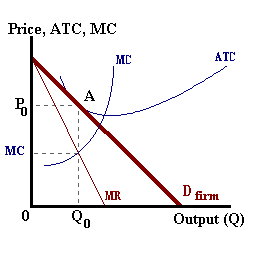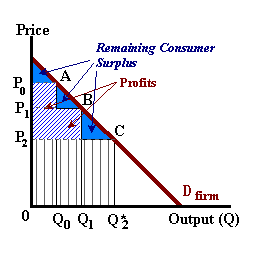
Many firms have the ability to charge prices for their products consistent with their best interests even thought they may not be characterized as monopolies. These price makers operate in competitive markets but find that due to unique characteristics of their products or industry they may have some discretion over product pricing.
In one category firms may act as monopolies with respect to their customers due to brand loyalty even though similar substitute products exist. These firms operate in, what is known as, a monopolistically competitive environment. They will engage in profits maximizing behavior (MR = MC) with respect to prices charged, however, competition in the industry will force product prices to some industry average. This average will be close to the average costs of production eliminating any abnormal profits for individual firms (point 'A' in the diagram below).

Business firms operating in competitive markets are not restricted to charging only one price for their product. These firms may find that by charging different customers different prices for a common product may actually increase the profits of the firm. This charging of different prices for a particular good is known as Price Discrimination and is very common in various markets around the globe.
Price discrimination is categorized into three types:
These three types all involve additional effort on the part of the firm to determine the preferences of different customers and their willingness to pay. These efforts are justified by a greater level of profits relative to that which can be earned by charging a single price.
This first approach to product pricing is based on the sellers ability to determine exactly how much each and every customer is willing to pay for a good. Different consumers have different preferences and levels of purchasing power and thus the amount they would be willing to pay for a good often exceeds a single competitive price. This difference between what a consumer is willing to pay and the price actually paid is known, of course, as consumers surplus. Thus a firm engaging in first degree price discrimination is attempting to extract all the consumers surplus from its customers as profits.
The seller will take the time to bargain or 'haggle' with the customer about the price that customer is willing to pay - some buyers willing to pay a higher price other buyers a lower price. The firm will sell a quantity of output ' Q*' up to the point where the price of the last unit sold just covers the marginal costs of production. The difference between the price charged on each unit and the average costs of producing ' Q*' units of output will be the firm's profits.

Common examples of first degree price discrimination include car sales at most dealerships where the customer rarely expects to pay full sticker price, scalpers of concert and sporting-event tickets, and road-side sellers of fruit and produce.
A second approach to price discrimination involves the establishment of a pricing structure for a particular good based on the number of units sold. Quantity discounts are a common example. In this case the seller charges a higher per-unit price for fewer units sold and a lower per-unit price for larger quantities purchased. In this case the seller is attempting to extract some of the consumer's surplus value as profits with residual surplus remaining with the consumer over and above the actual price paid. Like the case of first degree price discrimination, the firm will produce a level of output where the price charged just covers the marginal costs of production.
In the diagram below, we find an example of a firm charging three different prices for the same product. The price P0 is charged per unit if the buyer chooses to buy Q0 units of the good. A lower price P1 is charged for a greater quantity Q1 and the price P2 is charged for the quantity Q*2 (the level of output such that P2 = MC -- the marginal costs of production):

Common examples of second degree price discrimination include quantity discounts for energy use; the variations in price for different sizes of boxed cereal, packaged paper products; and sodas and French fries at fast food outlets.
A third type of price discrimination exists where the firm is able to segment its customers into two or more separate markets, each market defined by unique demand characteristics. Some of these markets might be less price sensitive (price inelastic) relative to other markets where quantity demanded is more sensitive to price changes (price elastic). The firm might find that by charging a higher price 'P1' and selling a level of output 'Q1' in the first market and a lower price 'P2' selling a level of output 'Q2' in the second market; profits are greater than in that firm charged a single price 'P* ' (P2 < P* < P1 ) for all units sold. Specifically, the firm will attempt third degree price discrimination if:
P1Q1 + P2Q2 > P*Q* (Q* = Q1 + Q2) , Total Costs are the same in either case)
In order for this type of price discrimination to be effective, the firm must be able to prevent a third party from engaging in arbitrage (buying in the second market at a price slightly above P2 and selling in the first market at a price slightly below P1 forcing both prices towards P*) and profiting from the price differences. The markets must be kept separate!
Examples of third degree price discrimination include: business vs. tourist airfares, business vs. residential telephone service, and senior discounts.